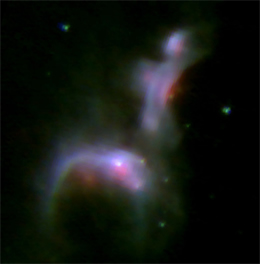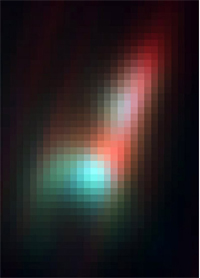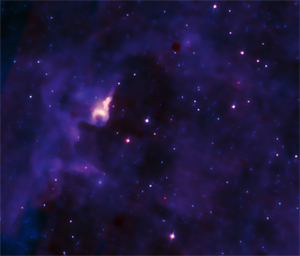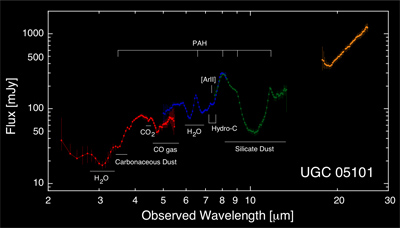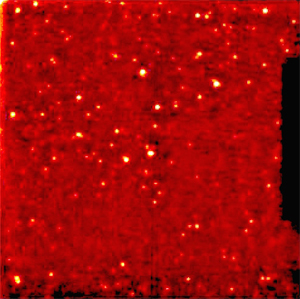TOP > Topics > 2007 > AKARI observes Star Forming Regions, Stars at the end of their life, Supernova Remnants, Active Galactic Nuclei, and distant galaxies.
![]()
AKARI observes Star Forming Regions, Stars at the end of their life,
Supernova Remnants, Active Galactic Nuclei, and distant galaxies.
The University of Tokyo,School of the Science
Nagoya University
Japan Aerospace Exploration Agency(JAXA)
The first Japanese infrared astronomy satellite AKARI, launched in February 2006, continues observations in good condition. Further initial scientific results will be presented in the annual meeting of the Astronomical Society of Japan on the 28th - 30th of March 2007. Five selected results are explained here. On this occasion, the research concerns observations chiefly using the Near- and Mid-Infrared Camera (IRC), one of the instruments onboard AKARI.
1. Star formation history revealed by AKARI wide-area survey observations.
–– Star formation over three generations in the nebula IC4954/4955 in the constellation Vulpecula ––
The cycle of star formation over three generations of stars was observed for the first time at seven different infrared wavelengths by AKARI. The results shed light on the process in which stars form in our Galaxy.
2. The first infrared detection of a supernova remnant in the Small Magellanic Cloud
AKARI detected for the first time, a supernova remnant in our neighbouring galaxy, the Small Magellanic Cloud in the infrared wavelength from 3 to 11 micrometres, and investigated the interaction between the supernova remnant and the interstellar material. This result will be presented in the annual meeting of the Korean Astronomical Society in April.
3. Stars in the later stages of their life cycle as seen by AKARI
–– Detection of mass-loss from relatively young red-giant stars in the globular cluster NGC 104 ––
AKARI detected evidence of high mass-loss rate from the relatively young red-giant stars based on observations from 3 to 24 micrometres. This finding provides us with new insight into to the evolution of the stars in the later stages of their life.
4. Molecular gas surrounding an active galactic nucleus with a giant black hole at its centre as seen by AKARI infrared observations
–– Detection of the molecular gas surrounding the active galactic nucleus in the ultra luminous infrared galaxy UGC05101 ––
AKARI has discovered evidence for molecular gas of different temperatures surrounding the active galactic nucleus containing an enormous black hole at its centre. This data will provide vital clues in understanding the structure of galaxies harbouring active galactic nuclei and black holes.
5. AKARI confirms an era of intense active star formation in the Universe
–– Deep sky survey in 15 micrometre infrared light ––
The Near- and Mid-Infrared Camera (IRC) onboard AKARI has carried out a wide area deep survey in 15 micrometre infrared light, detecting many galaxies. This result indicates that a phase of intense active star formation took place in the Universe, lasting several billion years over 6 billion years ago.
AKARI is a JAXA’s mission carried out with the participation of mainly the following institutes; Nagoya University, The University of Tokyo, National Astronomical Observatory Japan, European Space Agency (ESA), Imperial College London, University of Sussex, The Open University (UK), University of Groningen / SRON (The Netherlands), Seoul National University (Korea). The far-infrared detectors were developed under collaboration with The National Institute of Information and Communications Technology.
1.Star formation history revealed by AKARI wide-area survey observations.
–– Star formation over three generations in the nebula IC4954/4955 in the constellation Vulpecula ––
This study is conducted by Dr. D. Ishihara, research fellow at the School of the Science, University of Tokyo.
The cycle of star formation over three generations of stars was observed for the first time at seven different infrared wavelengths by AKARI. The results shed light on the process in which stars form in our Galaxy.
IC4954/4955 are reflection nebulae in the constellation Vulpecula, located around 6500 light years distant from the Sun. The left panel of Figure 1.1 shows a three-colour composite image from AKARI’s 9 (blue), 11 (green), and 18 (red) micrometre data. Regions in white are thought to be high-density regions. Two arc-like structures are clearly seen in the image. These are formed by a young, massive star (not seen in the image) at the centre of the nebula sweeping the material outward by their strong radiation pressure. Astronomers believe that new stars are formed in such high-density regions. The arcs are located at a distance of about one light year from the central star. The colour composite image from the far-infrared data (right side of Figure 1.1) shows that the arcs are also heated by the central star and appear blue.
Figure 1.2 is a two-colour composite from the 9 and 18 micrometre data of the surrounding region of the stellar nursery and is about 20 times broader than the previous figure. The brightest region in this figure is IC4954/4955. In addition a distinct hollow in the middle of the image is apparent. The diameter of this hollow is about a hundred light years. We suspect that an even earlier, first generation star formed around several to ten million years ago, and that this object induced the star formation of the second generation including the IC4954/4955 region.
The observations of IC4954/4955 were carried out with the Near- and Mid-infrared Camera (IRC) and the Far-Infrared Surveyor (FIS) instruments onboard AKARI carried out observations of this region at seven different infrared wavelengths (9, 11, 18, 65, 90, 140, and 160 micrometres). AKARI's images powerfully demonstrate that infrared observations are vital to detect the material that is invisible to us in normal visual light.
Figure 1.1(left)
[Click image for enlargement]
Figure 1.1(right)
[Click image for enlargement]
|
Figure1.2 |
2. The first infrared detection of a supernova remnant in the Small Magellanic Cloud.
This study is carried out by the research group lead by Prof. Bon-Chul Koo in Seoul National University, Korea.
AKARI detected for the first time, a supernova remnant in our neighbouring galaxy, the Small Magellanic Cloud in the infrared wavelength from 3 to 11 micrometres. The AKARI data reveal the presence of a shock at the interaction between the expanding supernova remnant and the surrounding interstellar medium. The result implies that the precursor of this supernova remnant was a high mass star.
The Small Magellanic Cloud is a small galaxy neighbouring our own Milky Way Galaxy at a distance of 200 000 light years, visible from the southern hemisphere. AKARI detected the supernova remnant B0104-72.3 in this galaxy for the first time at the infrared wavelengths of 3, 4, 7 and 11 micrometres with the Near- and Mid-Infrared Camera (IRC) onboard AKARI. Figure 2 shows the colour composite image of the supernova remnant. A pair of arc-like structures in the middle of the image are the supernova remnant extended to approximately 60x100 light years.
After a supernova explosion at the end of a life of stars much heavier than our own Sun, the matter ejected from the star expands into interstellar space and forms a supernova remnant. Supernovae provide materials for the formation of next generation stars. The contribution of supernova is an essential component in the evolution of our own and other galaxies. Observations with AKARI are expected to play a key role in understanding the evolution of the interstellar material via studies of interaction processes with the supernova remnant.
|
Figure2 |
3. Stars in the later stages of their life cycle as seen by AKARI
–– Detection of mass-loss from relatively young red-giant stars in the globular cluster NGC 104 ––
This research is mainly carried out by Dr. Y. Ita (ISAS/JAXA) and Dr. N. Matsunaga (Univ. of Tokyo)
AKARI detected evidence of high mass-loss rate from the relatively young red-giant stars based on observations from 3 to 24 micrometres. This finding provides us with new insight into to the evolution of the stars in the later stages of their life.
Stars with the mass similar to the Sun will evolved to red-giant stars at the late stage of their life. The red-giant stars eject their mass to the interstellar space, which is known as 'mass loss'. Theories predict that such mass loss takes place already in the early stage of the red-giant phase. However, observational evidence of high mass loss so far obtained are all from relatively evolved red-giant stars.
NGC104, also known as 47 Tuc, is a globular cluster visible from the southern hemisphere in the constellation of Tucana. AKARI observed NGC 104 with the Near- and Mid-Infrared Camera (IRC). Figure 3 shows a three colour composite image of the target from the 3, 11, and 24 micrometre data. The bright red stars seen in the image are mostly in the final stages of the red-giant phase and are losing their material at rates of as high as one millionth of their mass per year. A marked star located in the bottom-left corner is the star that was discovered to be losing mass at a high-rate while still in the early stage of the red-giant phase. The current result confirms the presence of mass-losing younger red-giant stars for the first time.
The fate of a star depends on how this mass loss takes place during the life of the star itself. Further analysis of the data and investigation, together with theoretical modelling will enable us to understand how mass-loss changes in the star's life.
|
Figure3 |
4. Molecular gas surrounding an active galactic nucleus with a giant black hole at its centre as seen by AKARI infrared observations
–– Detection of the molecular gas surrounding the active galactic nucleus in the ultra luminous infrared galaxy UGC05101 ––
This study is mainly carried out by Prof. T. Nakagawa and Dr. M. Shirahata in ISAS/JAXA.
AKARI has discovered evidence for molecular gas of different temperatures surrounding the active galactic nucleus containing an enormous black hole at its centre. This data will provide vital clues in understanding the structure of galaxies harbouring active galactic nuclei and black holes.
UGC05101 in the constellation Ursa Major is around 550 million light years away from the Earth. The very central part of this galaxy is so bright at infrared wavelengths, that the object is termed an ‘Ultra Luminous Infrared Galaxy’. The total energy emitted from this galaxy at infrared wavelengths alone is about one trillion times more than the total energy of our Sun. It has been postulated that a giant black hole is sitting at the centre of UGC05101, and actss as an engine of the galaxy. However, the central region of this galaxy is covered by a thick interstellar medium, and to this day has never been observed, thus the mechanisms at work in the core region remain a mystery.
Thanks to its high sensitivity in the infrared, AKARI has taken up the quest to unravel the mystery of the central core of HGC05101. Figure 4.1 shows the spectrum of UGC05101 from 2 to 13 micrometres observed with the Near- and Mid-Infrared Camera (IRC) onboard AKARI. The spectrum shows many signals from dust, molecules, atoms, and ions. We especially focus on the characteristics of carbon monoxide (CO) molecules in the gas phase. The observed feature is very broad, indicating that the temperature of this molecular gas is over 500 degrees Centigrade. It is suspected that the warm molecular gas detected by AKARI is indeed being heated by radiation from nearby the black hole.
|
Figure4 |
5. AKARI confirms an era of intense star formation activity in the Universe
–– Deep sky survey in 15 micrometre infrared light ––
This research is carried out by Dr. T.Wada, S. Oyabu(ISAS/JAXA) and collaborators.
The Near- and Mid-Infrared Camera (IRC) onboard AKARI has carried out a wide area deep survey in 15 micrometre infrared light, detecting many galaxies. This result indicates that a phase of intense active star formation took place in the Universe, lasting several billion years over 6 billion years ago.
Galaxies in which active star formation is taking place emit most of their energy as infrared radiation from the interstellar material heated by the light from the young hot stars. The light we observe from the distant galaxies, in reality, left the galaxies a long time ago. Infrared observations with the Infrared Space Observatory (ISO), the European infrared astronomy satellite launched in 1995, revealed that the number of faint, distant galaxies increased drastically when observed at 15 micrometres. This can be explained by the redshift effect, where the original light was emitted from the galaxies at a wavelength of 7 micrometres around 6 billion years ago. The conclusion was drawn from observations of a very small area of the sky containing only 24 galaxies detected in the infrared. Figure 5 shows the results of the deep survey observations at 15 micrometres by the Near- and Mid-Infrared Camera (IRC) onboard AKARI. We detected around 280 galaxies in this region. AKARI's observations concretely confirm the increase of the number of galaxies at 15 micrometres implied by the earlier ISO observations. Moreover, AKARI also discovered comparable numbers of even fainter galaxies, leading us to an important conclusion that the star formation activity was already high at times even earlier than 6 billion years ago.
AKARI is performing similar deep surveys over the entire wavelength range from 2 to 24 micrometres. Such multi-wavelength data will provide a definitive description of the dusty galaxy evolution over the life of our Universe.
|
Figure5 |
March 26, 2007





